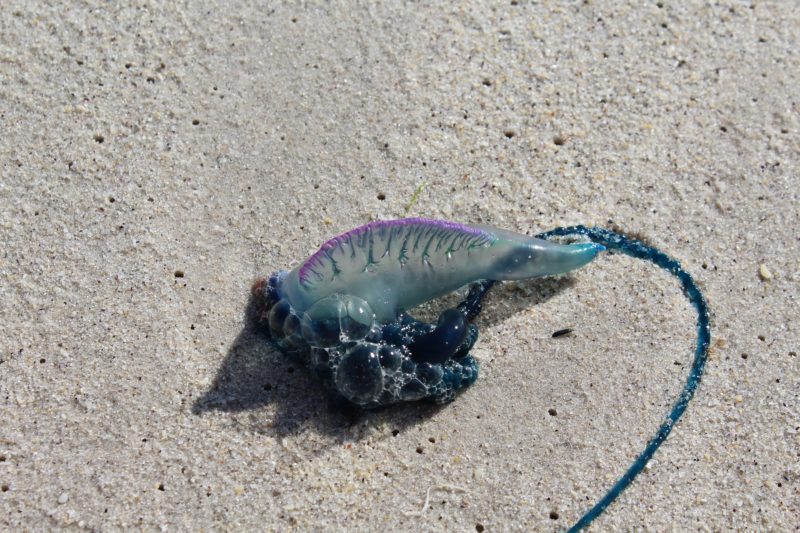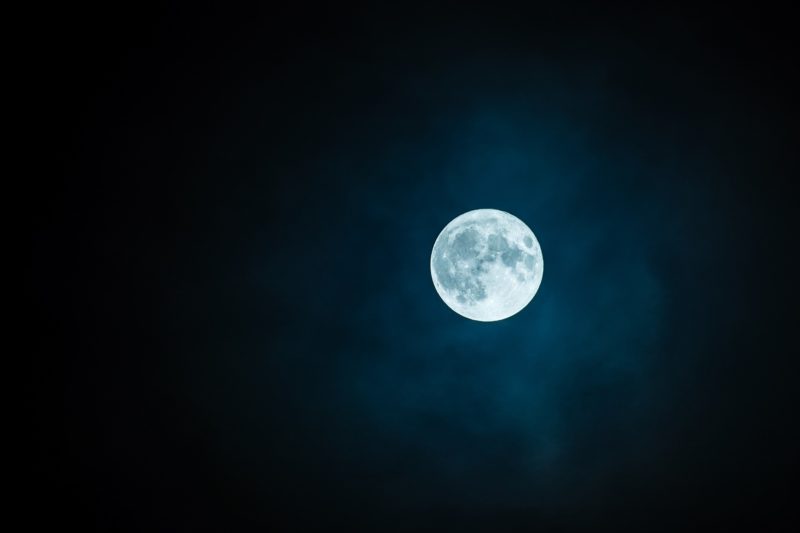This post may contain affiliate links, which means I'll earn a small commission if you purchase something through these links. You won't pay any extra; instead, you'll be helping Aloha With Love to thrive. Thank you! Learn more.
--
Let’s talk about a painful subject – jellyfish. Getting stung is NOT FUN. And many Hawaii visitors don’t realize that once a month we’ve got jellyfish swarms visiting our shores and making a sea of red welts and screaming children.
I barely remember my 1st sting. I do remember the fuss though. I was younger than 5 and my parents were washing me off in the shower and trying to comfort me. I ended up sitting on the beach with my Mom and I started to rub sand on the sting because it made the hurt and crazy itch go away.
My 2nd Portugese man-o-war sting? I remember that.
I was 11 or so and my Dad brought my brother and I to a harbor with 2 kayaks in tow. Dad and Michael went in one, and I went in another and off we went. The water was flat and although I struggled with the paddling in the beginning, I soon got the hang of it and we cruised the coastline together.
I distinctly remember feeling a dull, stinging sensation on my right knee, but shook it off. Nothing could dampen my happiness because I was a kid and I was paddling in a kayak by myself and I was doing an awesome job! I was a grown up and I was independent. But the stinging continued and I realized that the now sharp pain was turning off my happiness valve.
I glanced down at my knee and there it was – a long, thin strand of electric blue jelly legs that had come up through the scupper hole. The strand clung on like wet hair on skin and the worst part was I couldn’t touch it! I splashed water on myself, which was a huge mistake. The strand shifted positions and began to sting another patch of skin.
After some minor panic and with careful elementary-grade resourcefulness, I stuck my leg into the water and held on tight to the other side of the kayak so I wouldn’t flip. I realize now I must have looked like a goose. In the middle of a waveless ocean, plastered awkwardly on my side, I lay flat against the kayak with one leg trailing behind me – all while holding onto the paddle for dear life.
I also remember keeping my eye out for any Portugese man-o-wars drifting close to me. I did not want to get stung again in this embarrassing position. Anything floating was deemed dangerous and I whacked it away with my paddle.
Here’s to you having a jellyfish-free vacation in Hawaii. May your days at the beach be the exact opposite of mine on these 2 occasions.
Aloha with love,
Amy
Interesting fact: Portugese man-o-wars are siphonophores, not jellyfish. They aren’t related to each other at all. But in order to spread the word about beach safety in Hawaii, I’ll continue to refer to them as jellyfish since that’s what the general public in and out of Hawaii is familiar with. Otherwise the only ones who will benefit from this post are people Googling “Siphonophores in Hawaii”.
Stung By A Jellyfish? No Lifeguard? Don’t Pee On It.
From the time I learned what a box jellyfish or Portugese man-o-war was (remember that 1st sting?), I was told over and over again that peeing on it was a way to get rid of the pain. Locals love this (dare I say it) old wives tale. As I grew up, there’d be jokes on how to know if someone was your best friend (they were willing to do the deed). I even remember a young group of boys who proudly told me their war story against a box jellyfish or Portugese man-o-war and their friendly sacrifice for each other.
The belief was that vinegar should be applied to lessen the sting. But most people visiting the beach aren’t close to home and don’t carry vinegar in their car. Thus, obviously the next best step was to urinate on it. Of course.

This is one rare case where you’ll be better off ignoring locals like me. Don’t pee on a jellyfish/siphonophore sting. It’s even been proven scientifically by the University of Hawaii at Manoa and the National University of Ireland Galway.
Other home remedies such as Dawn dish soap, alcohol, baking soda, etc. were also tested and yielded little to no results. The worst was rinsing the sting off with seawater – this seems to only move around the stingers to fresh skin thus spreading the pain. As we originally thought, the best remedy is vinegar and a little warmth and you’ll be good.
A Personal Tip: I’m not sure how accurate this is, but I’ve tested this twice so far with Portugese man-o-wars. On my 3rd sting, I was floating with a friend in some waves and was stung on my upper right arm. I used my left palm and swiped down to get it off me. I noticed a few minutes later that while my upper arm was still feeling the effects, my left hand felt completely normal. So for the advancement of science, I tried touching Portugese man-o-wars with my fingers (palm-side) on my 4th and 5th stings. So far, both times have been pain-free and my theory is that it has something to do with the skin on the inside of our palm. The skin on your fingers feels different from the rest of the skin on your body, doesn’t it?
South-Facing Shores On Oahu Is Where Box Jellyfish Usually Float
South-facing shores on Oahu are impacted by box jellyfish the most. This includes the always popular Waikiki, Ala Moana and Hanauma Bay beaches. Other Oahu beaches that may be affected are the Kailua and Lanikai beaches, and even along the Waianae coast.
Poipu beach on Kauai may also be affected. If conditions are right, Maui and Big Island can also see them on occasion.
Local Tip: You can follow me on Twitter for jellyfish schedules. I send out jellyfish tweets on days where swarms are predicted. Or, if you’re planning your Hawaii vacation and want to avoid jellyfish swarms altogether, check out Waikiki Aquarium’s jellyfish calendar. You can also check the Hawaii Beach Safety website for real-time alerts on Hawaii’s shores including jellyfish activity, high surf, storm watches and brown water advisories.

When Do Box Jellyfish Come Close To Hawaii Shores?
Nature is pretty amazing.
The patterns of seasons, how animals wake up from hibernation in the nick of time…you have to admit that when it comes to timing, nature has been playing this game for a while.
It’s no different with Hawaii’s jellyfish. Roughly 8 days after a full moon, you can expect Hawaii’s jellyfish to appear and to hang around for 3-5 days or so. So if you plan on spending a week on Oahu in a Waikiki hotel, I’d consider checking your dates and choosing a jellyfish-free week for your Hawaii vacation.
Local Tip: Don’t let the threat of jellyfish scare you out of the water just yet. The jellyfish don’t hit our shores every every month. Sometimes several months will pass by and we won’t see a single jellyfish. These dates are only a “if they appear, they’ll appear 8 days after a full moon” warning. On the other hand, it is possible for jellyfish to randomly appear on particularly gusty days where the winds blow them in. But I wouldn’t worry too much about this as I’ve only heard about it happening “out of season” just once or twice.
Box Jellyfish vs. Portugese Man-O-War
Although box jellyfish tend to follow 8 days after a full moon, Portugese man-o-wars come into Hawaii shores via tradewinds. When our winds are exceptionally strong, you’ll want to check with a lifeguard or keep an eye out for any floating blue bubbles as you swim.

What Happens When There’s Jellyfish In The Water
At the first sign of jellyfish, lifeguards will put up signs along the beach warning the public that jellyfish are in the water. Believe it or not, some people will still go in for their swim despite the warnings. Not just because they’re crazy, but usually because the swarm is small in number. When there’s only a few here and there, hardened swimmers, surfers and divers won’t let a little blue sadden their day.
There are occasions where the swarms are large and you won’t see anyone in the water. On these days, both jellyfish and Portugese man-o-wars are washed up onto shore and the public and lifeguards alike walk in the sand with sticks, popping their bright blue bubbles and covering them with sand.
It’s a rather stress-relieving activity if you have the chance. How many people get to say “I popped jellyfish on the sands of Hawaii.” Such a satisfying pop.
Fact: Although the box jellyfish are known for their sting all around the world, Hawaii’s box jellyfish species is considered to have the weakest sting.
Lifeguards
Lifeguards are ready for any injuries and that includes jellyfish stings. Head to the beach’s lifeguards and they’ll help administer treatment.
Local Tip: Lifeguards are not at every single beach. If you plan on doing some swimming during jellyfish days, I’d recommend choosing beaches that have a lifeguard scheduled. That way if anything happens, they’ll be able to treat you.

